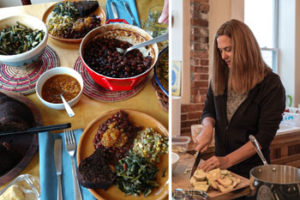Summerguide 2018 | view this story as a .pdf
Back-to-basic classic flavors create a memorable experience.
By Kate Christensen
 I moved to Portland from New York City almost seven years ago, in part because I fell in love with the food up here, the quality of the restaurants, the emphasis on fresh and local ingredients, and the joy and pride radiating from the purveyors at the farmers’ market.
I moved to Portland from New York City almost seven years ago, in part because I fell in love with the food up here, the quality of the restaurants, the emphasis on fresh and local ingredients, and the joy and pride radiating from the purveyors at the farmers’ market.
Hankering for a traditional, down-home meal made with local ingredients, I decided to make an old-fashioned bean supper from scratch. (Cue groans from those still suffering from Post-Traumatic Bean Supper Disorder after being dragged to the church weekend after weekend.)
Tried and True
Bean suppers date back to when hard-working Mainers, hungry from a long week of physical labor, came together for a big meal of beans, brown bread, and sides on Saturday nights. The meal was served in lumber camps, churches, and family homes alike. The beans were sometimes slow-cooked overnight in a cast-iron pot buried in a covered “bean hole” outside, but more often they were baked all day in low-temperature ovens. Because Maine used to be one of the top three states in dried-bean production, Mainers used cheap, abundant local beans such as Marfax beans or yellow eyes, which hold their shape and stay firm. They might also use Jacob’s cattle beans or soldier beans, which melt with the onion into the molasses-salt pork-mustard bath they’re baked in.
“You have to use Marfax,” James Beard Award semi-finalist Erin French tells me. Her Lost Kitchen restaurant in Freedom is famed across New England, so I take her cooking advice seriously. “We had baked beans on winter Saturdays when I was growing up. I don’t mess with the traditional recipes. My grandmother and then my mother made baked beans the traditional way, with salt pork, ketchup, molasses, onion, and dry mustard. And Marfax beans. They’re the creamy little brown ones that keep their shape. They stand up.” Though you’re bound to find a chic revision of baked beans with the hashtag #heirloom on Instagram, Grandma knows best. “We use yellow-eye beans in ours,” counters Kathy Sherman, owner of Sherman’s Farm Stand, which is technically across the state line in New Hampshire, but only a stone’s throw from Fryeburg, Maine–in my mind, anyway. “They don’t turn to mush.”
Back in the old days, while the beans slow-cooked, a loaf or two of brown bread steamed in coffee cans set into a kettle. This tangy, chewy bread was made with equal parts cornmeal, white, and rye flours, with or without raisins, plus dark molasses, milk or buttermilk, salt, and baking soda. The combination of flours came about from typical Maine pragmatic thrift, since white flour was expensive. The bread was steamed because it was often made outside, on a campfire.
Of course, Mainers ate this way primarily because it was easy, cheap, and hearty. Bean suppers nourish and satisfy, they stick to the ribs. But a heap of rich, porky baked beans and a slab of fresh brown bread with thick-spread butter also makes a delicious meal. It is to inland Maine what the clambake is to Down Easters: the quintessential communal suppah, perfect for a crowd, beloved by everyone, made out of food grown close to home, augmented with those perennially cheap staples, cornmeal and salt pork and molasses.
Two Sides to Every Recipe
Traditionally bean hole suppers included a variety of side dishes, depending on the season and on what was bursting out of the garden or put up in plentiful jars on the pantry shelves: stewed greens; carrot and cabbage coleslaw; green-tomato piccalilli relish; and succotash, made with fresh sweet corn cut off the cob plus whatever fresh-shucked beans were plentiful. “And red snapper hot dogs,” says French. “Is that a side? Sometimes we cut them straight into the beans. And we always had either Waldorf salad or coleslaw.”
“Braised dandelion greens with bacon and just a teeny dollop of maple syrup and another of apple-cider vinegar,” says Ladleah Dunn, whose recently opened Lincolnville General Store in Midcoast Maine offers an array of local delicacies. “And piccalilli with the baked beans.”
“Pickles on baked beans?” To French, this sounds suspect. “Never. It’s too much sweet on sweet.”
You say Marfax, I say yellow eye–Mainers are nothing if not opinionated about food. To which I say, amen, and pass the piccalilli, so I ask Dunn for her recipe. She gives me a fast version she dubbed Quickallili: Seed and mince, pulsing in the Cuisinart, a heap (two pounds) of green tomatoes and a handful of shallots. In a pot, throw together a solution of half rice vinegar and half Mirin sweetened sushi vinegar, about a cup of each, with pepper, salt, brown sugar, mustard seeds, a couple of bay leaves, a few cloves, and hot red pepper flakes, and boil it for a couple of minutes. Mix with the tomatoes, cover, and let it sit overnight in the fridge, or up to a week.
Craving something light, but creamy and starchy as well, I decide to try my hand at succotash. When I was growing up, succotash always came frozen or from cans, and I hated it: mushy lima beans, tasteless corn kernels, held together in a gelatinous broth. But one night, when I was out for dinner at Scales, Sam Hayward and Dana Street’s joint seafood restaurant on a wharf off Commercial Street in Portland, I ordered the succotash as a side to a bucket of steamers. When it arrived, I took one bite and swooned. It was a revelation. This succotash was bright, fresh, rich, and glossy. It melted on my tongue.
“It’s always seasonal here,” Chef Travis Olson tells me. “In the spring, we use the earliest shelling beans. They have to be fresh–that’s what makes it special. We’re waiting for the first fava beans now. They’re meaty, sweet, and savory, less starchy than limas. And we use fresh-shucked sweet corn, and this time of year, some spring onions or garlic scapes. And butter, and a combination of rich chicken stock and a broth made from the corncobs. We add minced salty, smoky country ham in kernel-sized bits. And some mild heat–chili flakes or pureed smoked jalapenos. Maybe a roux. Not a gravy–just to make it cohesive, so the liquid clings to the vegetables.” “How much butter?” I ask, my mouth watering so much I can hardly talk. “Plenty,” he laughs. Okay, so maybe this one isn’t filed under “lighter cooking,” but who can argue with that?
Let’s Eat
With my menu complete, all that’s left are the ingredients. Even though it’s early spring, and very little is growing here yet, I manage to stick close to home for some of my groceries. I find yellow-eye beans from Green Thumb Farms at Sherman’s. For the brown bread, instead of rye flour, I use Bouchard Family Farms Acadian buckwheat flour from Fort Kent. At Hannaford, I buy a big bunch of locally grown fresh dandelion greens and Maine-raised bacon and ham. But, I confess, no red snapper hot dogs, which feels like a capital crime. And I score a couple of bottles of Moxie, the traditional Maine soda flavored with gentian root. To me it tastes like a slightly bitter version of root beer, its medicinal cousin.
On Friday, I tackle Dunn’s Quickallili and set the yellow-eye beans to soak overnight. On Saturday morning, I start the baked beans, using the New York Times classic recipe. I make my own version of brown bread, using Maine buckwheat flour in place of rye, a cup of raisins, and almond milk with vinegar instead of buttermilk, since that’s what I had on hand. Travis’s succotash is my next project. Since there are no shelling beans available yet, I use baby lima beans (sorry, Travis). And, strictly for research purposes, I use plenty of butter, simmering the shallots, minced ham, and lima beans in the two rich broths until the liquid has mostly cooked off. Next, I add the corn and spring onions and let it all cook until it has coalesced into a sweet, melting stew. Finally, I make Ladleah’s savory, surprisingly luscious dandelion greens.
This elaborate menu–beans, bread, ‘tash, greens, and relish–is all just for my husband and me, not a church full of neighbors, or a big farm family, or a lumber camp crew gathered around a long table. But it feels festive, and eating the delicious results of the generous advice I’ve gleaned from Maine chefs, I feel both connected to tradition and happily well fed. And the leftovers, reheated, will last for days.
To go along with the meal, I’ve invented a crisp, herbaceous cocktail to celebrate my new home’s culinary roots. I call it the Moxie Foxtail: Into a shaker with ice, pour a jigger of bourbon and another of Aperol, then another of fresh lemon or lime juice. Shake briefly and pour with the ice into a highball glass. Top with Moxie, mix with a stirrer, and toast the incomparable flavors of a Maine bean supper.





0 Comments